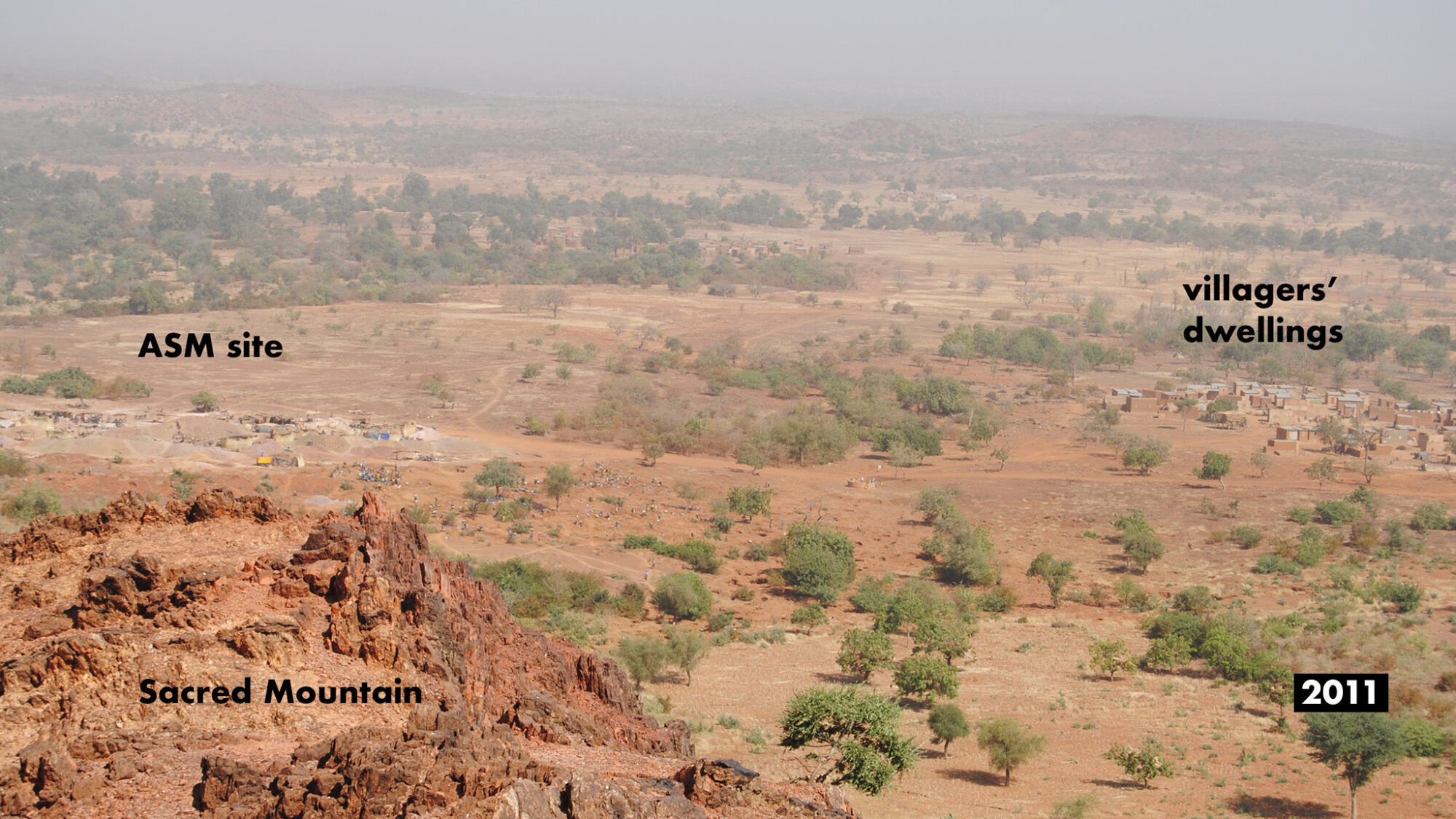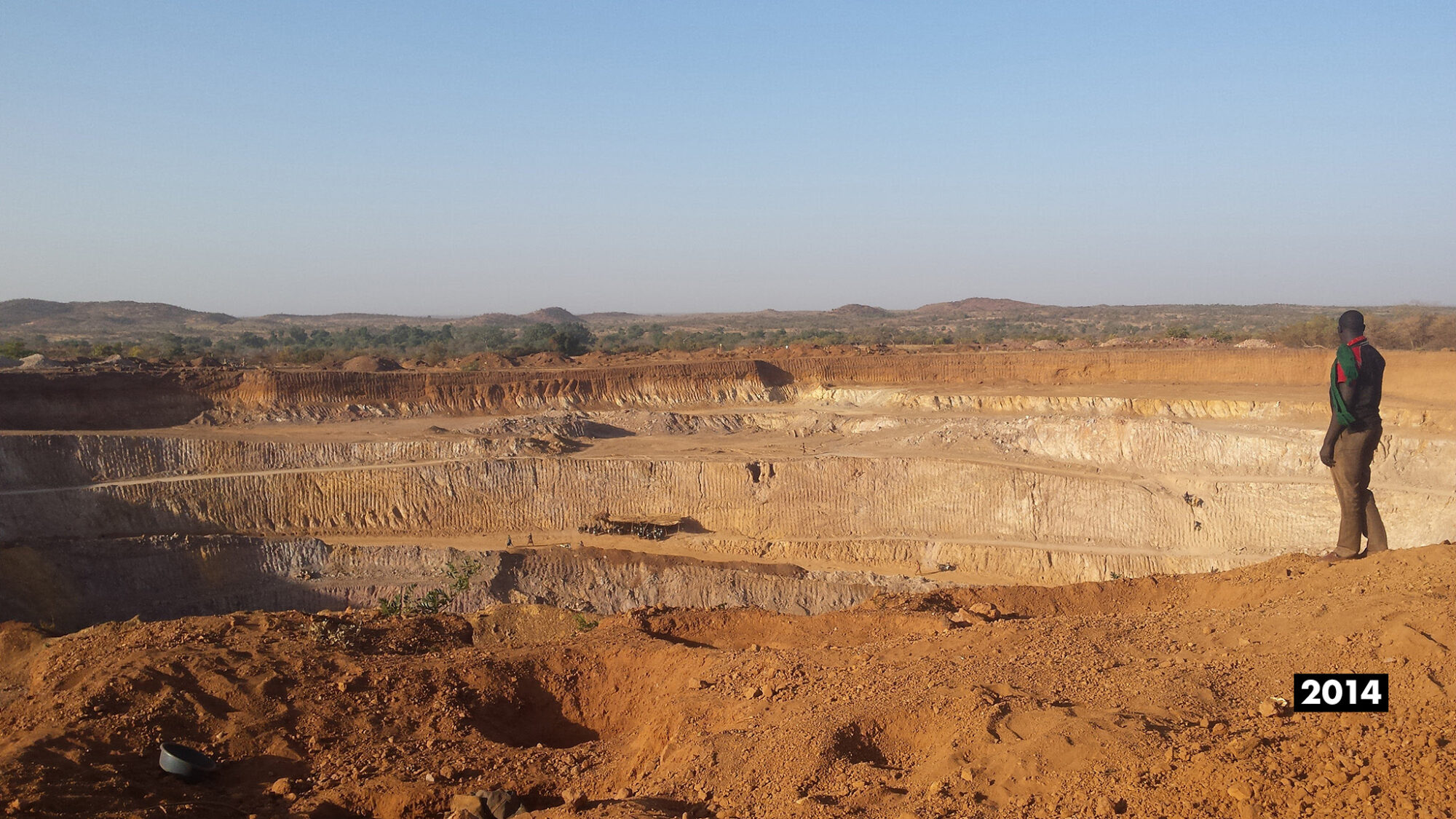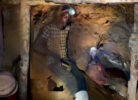The wall texts throughout the exhibition illustrate the complexity of the global supply chain for gold and rare minerals. – Scroll down for additional information.
Around 80% of the global labor force involved in mining is occupied in so-called artisanal or small-scale mining activities. That is a total of 45 million workers across 60 countries, mainly in the Southern hemisphere. By contrast, the other 20% of the workforce are occupied in industrial mining, which accounts for 80% of the world's production volume.
In gold mining specifically, about 10 to 15 million artisanal and small-scale miners are estimated to work worldwide, including 4.5 million women and 600 000 children. Their total labor represents an output of about 380 to 450 tons of gold per year, or 17–20% of global gold production.
Small-scale mining can prove to be a forerunner to large-scale industrial exploitation. Often, a mining area is bought up by industrial consortia when profitable returns from small-scale miners can be observed. A large proportion of artisanal miners are thus forced out of business by large-scale industrial exploitation. Similar dynamics are at work for other precious minerals needed in the digital industries.
Examples of the violent relationship between industrial and artisanal mining can be found in the region surrounding Kamituga – but also in many other places around the world. Here is an instance from Northern Burkina Faso (2011 to today):
It is important to first understand the differences between industrial and artisanal gold mining. Artisanal mining often relies on manually dug shafts and teams of laborers above and below ground who sometimes work in day and night shifts to process ores from shafts that can reach depths of 100 meters. Whereas Industrial mining frequently makes use of “open pit” mining, and involves more highly mechanized and safer work practices. The latter is often privileged by governments in receiving permits, and the permits are often exchanged between companies for millions of dollars, whereas the artisanal miners and surrounding populations often receive close to nothing or relatively very little in compensation for their losses – partly due to the informal nature of their work.
The snapshots below from Northern Burkina Faso illustrate the violent relation between these kinds of mining through the history of a specific place that started as an artisanal mine and was violently but legally seized for industrial mining. Two kinds of views are presented to give a sense of this history: 1) views from the nearby sacred mountain of the mining site, 2) views of the site from the ground through pictures at different times.


Fig1-2: Two views of mining sites from sacred mountain looking North – before and after a large-scale open pit mine was built and exploited (between 2012-2014) over previous artisanal and small scale mining sites (ASM).

Fig 3: A snapshot view of the same artisanal and small scale mining site (ASM) from the ground in 2011, before the large-scale mining pit was built over it.

Fig 4: A snapshot view of the same mining site in 2014 when the multinational mining company abandoned the large-scale open pit mine it built over artisanal and small scale mining sites (ASM). The pit was not rehabilitated – it was left open – and ASM re-started in the pit. Today, not much has changed.
More information about the political economy of the above case: After the Goldrush
More information about the situation in the region of Kamituga: Artisanal mining and industrial mining in Eastern DR Congo
Worldwide 30 to 50% of artisanal and small-scale mining is undertaken by women and it is highly gendered work. Men and women usually take up different kinds of jobs according to specific gender norms and these norms influence the way their work is valued. Some mining jobs are mostly undertaken by men (eg. digging underground) while others by women (panning above ground). Importantly, women are often those engaged in the reproductive work that is necessary for miners to undertake their activities, whether this is through paid jobs (e.g. selling food and water) or unpaid jobs (e.g. looking after miners’ children).
These different jobs are conducted within the context of dominant patriarchal norms that undervalue female-dominated jobs and that promote violence against women in and around mining sites. Overall, women earn lessthan male workers on the ground and they have a multitude of additional paid and unpaid tasks compared to male workers. In some instances, when their work becomes more profitable than that of men, it is taken out of their control. These are some of the many issues pertaining to gender rights in small-scale mining.
More information on the gender specific working conditions: Rosemarie Mwaipopo: Women rights and gender equality in Tanzania
The topic of child labor is difficult, partly because it is not clear whether the participation of children in artisanal and small-scale mining prevents or enables their attendance at school. Some estimates suggest that between 30 and 50 percent of artisanal mining workers are children. The jobs children do are mostly “helper” jobs that are common in informal agrarian economies (e.g. family farming). In many instances children skip school to work on the mines where they are able to earn a little money. While some argue that children working on mine sites takes them away from school, others show that their work in the mines pays for their school fees. These complexities are tackled in the reports added below.
More on child labor: Gold from children's hands, Child labour in mining , in French: Opportunités, défis et espoirs dans le secteur de l’or à Kamituga
More about the global context:
Stigmatized Workers, Precarious Situations
How About Switzerland?
Livelihoods for Millions
What Can We Do?
Share your impressions, observations and questions on our visitors' comments page.
Department of Geography, University of Zurich:
Research, interviews, 3D scans, videos, photographs: Gabriel Kamundala, Department of Geography, UZH
Supervision and textual content: Dr. Timothy Raeymaekers, Department of Geography, UZH,
Dr. Muriel Côte, Associate senior lecturer, Department of Human Geography, University of Lund
Research partners:
University of Zimbabwe
University of Ouagadougou I
Institut National des Sciences des Sociétés (Burkina Faso)
Groupe d’Etudes sur les Conflits et la Sécurité Humaine (DR CONGO)
Immersive Arts Space, Zurich University of the Arts ZHdK:
Scenography: Mariana Vieira Gruenig
Interaction Design, 3D Experience: Chris Elvis Leisi
Spatial Augmented Reality Engineer: Florian Christoph Bruggisser
Video editing, storytelling: Alan Sahin
Sound design: Patrycja Pakiela
Additional on location audio recordings: Alfred Borauzima
Translation, proofreading: Alliance Riziki Murhula, Edward Wright
Voice over: Shabnam Chamani, Rino Hosennen
Chief technician: Sébastien Schiesser
Production manager: Kristina Jungic
Project lead: Prof. Christian Iseli
